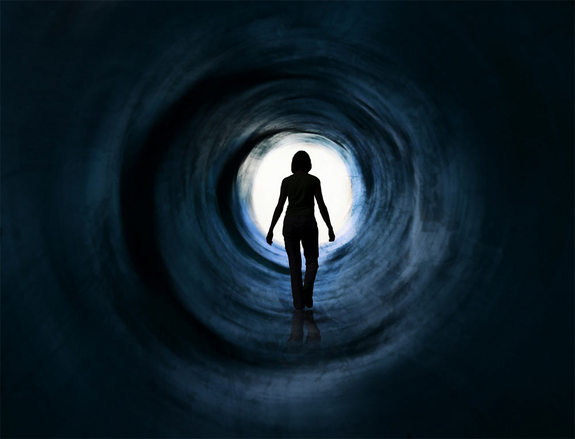
"Seems to be that all of us can be placed somewhere along a sliding scale, based on how unstable or erratic our temporal lobe is, and some people are more prone to these experiences," said study researcher Jason Braithwaite of the University of Birmingham.
The temporal lobe interprets the sensory and other information coming in from the body and places it on a body map, giving us our sense of being inside our body, of looking out from our eyes. If this interpretation goes wrong, a hallucination can occur in which a person sees themselves from outside of their body, also called an out-of-body experience (OBE).
Experiencing the body
Out-of-body experiences are traditionally thought of as occurring during a near-death experience, but these aren't the only situations in which OBEs occur. They often occur during relaxed and wakeful states, or during migraines or temporal lobe seizures. About 10 percent of people in the general population have experienced an OBE. In college undergraduates, this number is double (researchers don't know why), usually falling somewhere between 20 and 25 percent.
In the researchers' sample of 63 undergraduates, 17 individuals (26 percent) reported having experienced an OBE. The volunteers filled out a questionnaire to assess their mental state. Those who had reported having an OBE showed differences on only two parts of the questionnaire: those that indicate instabilities in the brain's temporal lobe and errors in the body's sense of itself.
To measure a participant's temporal lobe stability, the surveys included questions such as: "Do you ever sense the presence of another being, despite being unable to see any evidence?" An example question from the body-distortion measures: "Do you ever have the sensation that your body, or part of it, is changing or has changed shape?"
Participants also completed a computer-based task where they were asked to imagine being in the place of a figure on the screen and to identify parts of the body (like "Which hand is the figure's glove on?"). People who had experienced OBEs were slower in their responses and more prone to make errors.
Distorted data
The distortion in our sense of bodily self could be caused by either conflicting information coming in from the body, or from disruptions of communication in the temporal lobe, which processes this information into a body map, Braithwaite told LiveScience.
"Your sense of self, of where you are in space, is not automatic, your brain needs to work it out all the time," Braithwaite said. "It's constantly sampling that information and constantly making that interpretation of where you are in space, and sometimes that interpretation goes wrong."
When this interpretation goes wrong, it could be the cause of an out-of-body experience.
The study was published in the July 2011 issue of the journal Cortex.



Reader Comments
...for willful and intentional
OBE's
Here's why this is non-sense. The article postulates that some form of non-local centering is the cause for seeing the self outside the body. Ok - I'll buy that this kind of thing happens. Your hyper-dimensional sensory array do so very strange things during deep meditation - I have personally felt sensations where the left and right sides of my body seem inverted, and another sensation where I felt like a point singularity. There are other varieties as well.
But in this particular case, the rationale is bunk - and here's why.
In order to visually "see" yourself from a 3rd person perspective, your visual sensory totality (i.e. the physical, optical mechanism of the eye itself, the optic nerve, and all of the brian which processes this raw data) has to actually have visual data from that perspective. To to say that this is purely a function of the relocation of the center of "self mapping" or sensory locale mapping (i.e. the brain imposing the sense that "you" are in the center, and the eyes are seeing forward from the center of "you") completely ignores that fact that there would be no optical data of "you" from outside your body, because regardless of where your brain projects your eyes to be, they are in fact physcially located on the front surface of your skull, and therefore cannot possibly generate visual data of a view from "outside" yourself.
The premise of this article is not only obviously incorrect, but it is also somewhat amusing that the author never realized this most obvious flaw in what amounts to simple deductive reasoning.
It is therefore much more logical, that some form of multi-directional, multi-dimensional kinetic sensing is available to all of us without the use of an optical device to generate data, and is capable of viewing the "projection space" from any angle, and from any dimensional context.